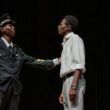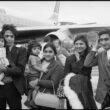July 7th, 1990 the first Saba saba, was a bloody day. The call for multipartyism had triggered a fury bottled up for many years by Kenyans, especially the youth. Kenyans born in the 60’s and 70’s had only witnessed Kenyatta and Moi’s oppression and not the direct rule of the colonialists. The earlier generation who lived under colonial rule somehow were mesmerized by the “freedom” they were experiencing under the black rulers, which when compared to what they were going through under colonial rule tasted, felt and looked like true freedom. One cannot underestimate their suffering and struggle to kick out the colonial government. It is therefore fair to argue that they were both tired and traumatized but also mesmerized by the new freedom, not to notice that indeed there was not much change in political leadership. The white rulers had been replaced by the black rulers, but their attitude and agenda towards the people did not change.
The youth of the 60’s and 70’s who had come of age during Kenyatta’s rule, and others who were coming of age during Moi’s rule, however, had only the current oppression to relate with. By then the country had almost been silenced, with the busting of MWAKENYA underground organization in the late 80’s, nyayo house tortures and kangaroo courts that had sent even the courageous few scampering for safety outside the country.
The call for return to multipartyism therefore, and the subsequent call for a Kamukunji, was enough trigger for angry youth to come out. Even though the convenors were subdued to call the Kamukunji off through arrests and subsequent detention, but the horse had bolted out of the stable! People came out in their thousands, not only in Eastlands where the Kamukunji grounds are located but also in other neighborhoods like Kwangware, Kikuyu, etc. The day was bloody as police felled many with their bullets. The numbers who died on July 7th 1990 may never be ascertained. This writer was then a 19-years-old waiting to join campus, and was in Kawangware where one had to almost jump over bodies lying all over the road while looking for a way to leave the area. This triggered some courage in all those who witnessed, that no matter the show of might by the state, when the people arise, they can win against oppression.
The courage exhibited on this day buoyed more hope for true freedom, and scores of people, mostly the youth started creating sites of struggle. One such site was the bringing to Kenya or launching in Kenya of the Release Political Prisoners (RPP) pressure group, which was a home base for the one abroad. Mothers of the then political prisoners sought the late Prof Wangari’s help, which led to staging of the famous hunger strike at the now famously known Freedom Corner. The mothers were supported by youthful activists. Moi was brutal, and so it took a lot of courage on the part of Prof. Maathai and more so the youth around her, even to meet at her house, let alone to execute the hunger strike at freedom corner.
RPP became a space for serious organizing of the Saba Saba Kamukunjis, and later, Citizens Coalition for Constitution Change (4Cs) and National Convention Executive Council (NCEC), both whose bulk of “foot soldiers” were in RPP. Saba saba and RPP cultural week remained the two national events or spaces that RPP actively organized.
Much of coming out to attend Kamukunjis, and especially political rallies is usually euphoria, and the awe of being with politicians (leaders). When RPP and other organizations with a grassroot appeal or orientation was actively involved in planning, however, there was much more political education that went into organizing the events. Among the masses attending the rallies there were pockets of politically conscious activists who held a deep conviction that these actions and events were cogs in the wheel of the bigger struggle for emancipation, and not a show-off or a feel-good adventure for the media or the politicians. Neither were all the lives being lost just so as to replace one president with another who thinks and acts the same. In the early 90’s, the regime was still very brutal, but also the country was in that space or moment of political reawakening. Civil Society then was quite broad and included all outside the state including opposition parties, religious organizations, the NGOs that had started either coming out against oppression or were being formed in that space.
Planning for Saba saba in the early years of the 90’s was therefore both political and scientific. This is in the sense that those like in RPP who were in the struggle not just to remove Moi but to uproot Moism and change the system, worked scientifically to make the Saba Saba events count towards achieving this, while those who just wanted to replace Moi were for the crowds and press. One has to remember that RPP had MWAKENYA members among them, those whom the RPP had fought for their release who immediately upon release joined the group, like the late Karimi Nduthu, Tirop Kitur and Kang’ethe Mungai, and those they recruited when they came out of prison like this writer. Political education therefore played a major role in planning and execution of the saba saba events.
This writer remembers one rally in the early years, where execution was almost military style. The plan was to organize groups of activists to approach Kamukunji from many sides and in many groups so as to divide the police forces on the ground. The aim was to ensure that at least a few people, if not all, got into the field which used to be barricaded from the previous day by GSU and regular police. It was like battalions approaching the battle field from all sides. It worked. While GSUs and police got engaged in stopping a large group that was being led by Comrade Githuku, the group that was being led by this writer managed to get into the Kamukunji grounds. They were few and were immediately surrounded by some of the GSUs and made to squat. Here was a moment where only innocent courage, born out of understanding why one was engaging in such risky activities, could keep one breathing. There was no “prominent” person among this small group, but this writer remembers standing up from the squatting, and looking around the periphery of the field, and spotting two “prominent” persons in the struggle, Prof. Alamin Mazrui and Dr. Willy Mutunga, who were signaling to her in sign language and low voices that they were in solidarity. The media aired a clip showing this small group surrounded by gun-wielding GSUs, squatting on the ground, and one standing up in defiance; innocent courage! It is the same courage exhibited recently by an activist who resisted arrest and led the chant that “when we lose our fear, they lose their power.”
A number of things led to Saba Saba spirit “going to sleep” for a while: first, the organizations that had a true connection with the grassroots, and who had the deeper and longer term agenda of true emancipation as opposed to short term election or power acquisition agenda, these organizations slowed down or changed face to be more NGO than grassroots, and eventually closed down. Second, a big chunk of the Civil Society luminaries went into government when Kibaki ascended to the presidency. While there and running the same machinery left in place by Moi but now for a new ruler, and having known the operatives of the Civil Society they left, they started clipping, instead of aiding the Civil Society to hold government to account. This, and a systematic attempt by the state (read politicians) to infiltrate Civil Society and weaken the link between organized Civil Society and the masses derailed even well-meaning activists for true emancipation within Civil Society.
The spirit of Saba saba has never died despite the brutality of the state. It may have reduced its intensity but to date, activists always try to commemorate that day in various ways and spaces. However, it seems as though the spirit rhymes with fever of what is happening in the country. In the 90’s and 2000’s, fever for change was pitch high. Politicians who just wanted power have kept derailing the masses to believe that the change they desire is the same as their desire to ascend to power. A large majority of Civil Society, specifically the opposition parties and the religious sector therefore changed tune to supporting or being in government when Moi was removed. Organizations that were truly grassroot like RPP and NCEC died, and the bigwigs in Civil Society NGOs took sides politically and have not been able to recover from the political divisions that led to the 2007-2008 debacle. Infiltration by state has almost obliterated Civil Society, such that Saba Saba is just an event for some to capture media attention that they are fighting for change. Others use this space to build their profile so that they can attract the highest bids from the politicians, while others use these events to collect donor funding.
While the spirit of struggle lingers on in the oppressed masses, the current generation also needs a genuine spark. And torch bearers who will shine the path so that they can walk, the path to true liberation, not to demand for crumbs in the name of inclusion or representation in a hopelessly flawed system, designed to ever hold them in servitude.
30/10/2020.





